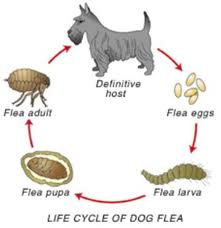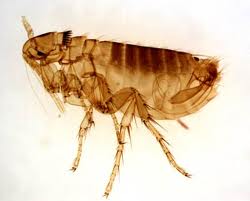FLEAS! What To Look For on Your Dog
Okay don’t judge me, but I remember having lice a young girl and it was not pleasant. My head itched profusely and I’ll never forget the first time I picked that little critter out of my head, all stuck in my nail and everything! I freaked! I ran home and to Daddy and he fixed me up. Like a good father he washed my hair with the lice killing shampoo and that sat for hours in the living room that evening picking out eggs from my long hair with a small comb. Now, THAT is commitment and love if you ask me. That is the type of urgency we need to take with our pets if we notice they have fleas. It’s not just their head that itches, it’s their ENTIRE body. The poor things are miserable with fleas and not to mention their health could definitely take a major stumble if the fleas persist. And you are definitely mistaken if you believe fleas cannot bite humans.
 There are over 2,000 species and subspecies of fleas. They prefer and thrive in warm, humid environments. I grew up in Texas and from personal experience I can tell you that is true statement. The feed on the blood of their host, your pet. The flea you will find on your dog is scientifically named Ctenocephalides felis, or the cat flea. They are dark in color, black or brown and are about three millimeters in long.
There are over 2,000 species and subspecies of fleas. They prefer and thrive in warm, humid environments. I grew up in Texas and from personal experience I can tell you that is true statement. The feed on the blood of their host, your pet. The flea you will find on your dog is scientifically named Ctenocephalides felis, or the cat flea. They are dark in color, black or brown and are about three millimeters in long.
Why do dogs get fleas?
These little pests are nimble and quick! They are laterally flat and have three pairs of legs, allowing them to jump up to two feet in the air. They can jump up to 10,000 times in a row, enough to cover three football fields! It is very easily for them to maneuver quickly around a dog’s fur.
Depending on the environment, a fleas lifecycle is about 16days to 21 months. You will most likely find fleas on your dog’s head, base of tail or abdomen. But they can thrive in any area of the body, which you will see with heavy cases of infestation. They will feed about once every day or two and continue to live on your dog even when they are not feeding.
Signs of Fleas
· Allergic dermatitis (skin problems)
· Pale gums
· Tapeworms
· Excessive licking, scratching, and/or biting
· Hair loss
· Flea eggs in the fur or in the environment
· Droppings or ‘flea dirt’ in the fur
Problems With Fleas
They may be small but that can consume up to 15 times their body with in blood. They are like mini vampires. The amount of blood loss in your dog could cause anemia. This is especially a problem in young puppies. An inadequate amount of red blood cells is life threatening. If you notice your dog having pale gums, lack of energy, or low body temperature, he may have parasitic anemia.
Sometimes your dog may have an increased sensitivity to the flea’s saliva. This could lead to flea allergy dermatitis. If this is the case it only take one bite from a flea to start an allergic reaction. Your dog will have intense itching and discomfort all day long. If you notice hair loss, red skin, scabs, and hot spots, you will want to take action before this turns into a skin infection.
What dogs are more prone to fleas?
Fleas thrive at temperatures between 60 and 80 degrees. If your dog lives outside and/or in a warm humid climate he is more prone to fleas than those in cooler climates.
Treatment of fleas
 Always consult with you family vet. They will know what is best for you dog. Flea medications can be toxic so it is important to allow a vet to assess your dog and the environment before making the correct medication decision. He will also be able to give you advice on preventing fleas in the future. If you have multiple pets you must treat each one for fleas, even if they have no signs of them. Most flea medications are topical and will be applied to the back of the neck. There are also over the counter sprays, shampoos, and powders. As normal, prescriptions are usually more effective though. Blue dawn dish soap is an old wives tale from the south that actually works really well as a flea shampoo. Some product will kill eggs as well as the fleas, but the all vary. Be sure you do not use cat medication on your dog and vice versa. Using a flea comb on your dogs fur weekly will help future infestations.
Always consult with you family vet. They will know what is best for you dog. Flea medications can be toxic so it is important to allow a vet to assess your dog and the environment before making the correct medication decision. He will also be able to give you advice on preventing fleas in the future. If you have multiple pets you must treat each one for fleas, even if they have no signs of them. Most flea medications are topical and will be applied to the back of the neck. There are also over the counter sprays, shampoos, and powders. As normal, prescriptions are usually more effective though. Blue dawn dish soap is an old wives tale from the south that actually works really well as a flea shampoo. Some product will kill eggs as well as the fleas, but the all vary. Be sure you do not use cat medication on your dog and vice versa. Using a flea comb on your dogs fur weekly will help future infestations.
Make sure you clean your house thoroughly. Anything that has upholstery, carpet, rugs, and all bedding need to be vacuumed and/or washed. Don’t forget to wash Fido’s bed as well. If the flea infestation is sever you may want to consider taking the time away from the house and using a spray, fogger or bug bomb as we used to call them. Your yard is just as important as your house when you clean. If you clean one without the other you will be stuck in a vicious cycle of fleas. In the yard concentrate more on the shady areas and use insecticides to kill the flea larvae.
Fleas are pests, I know. But with any health issue if you take preventative actions and keep the environment clean it will decrease your chance of having to deal with the issue. But if you do, do not be lazy in taking action. The very first sign of fleas you must begin a thorough cleaning. We all want happy healthy dogs, and trust me humans, flea bites are worse than ant bites.
Other Popular Health Articles
Common Health Problems
Credits Here

